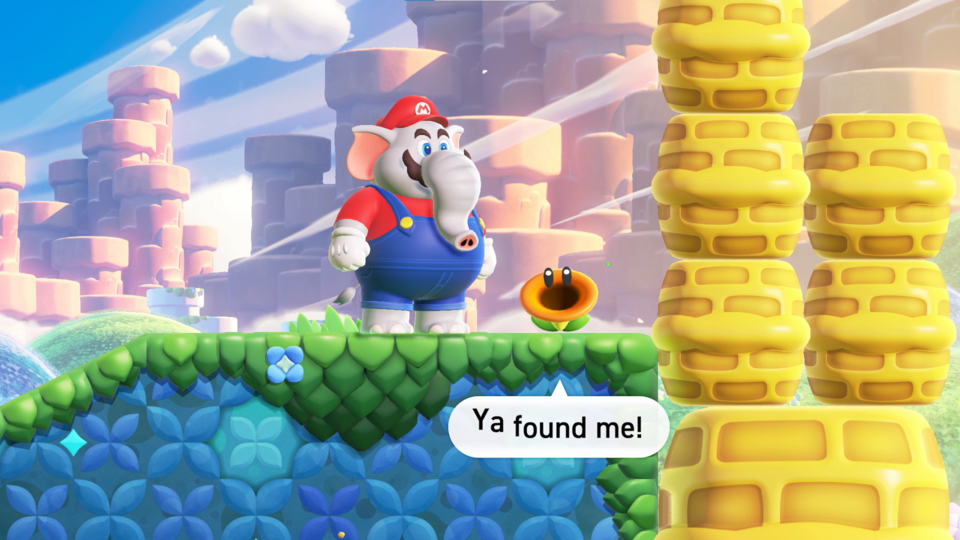A ‘Wonderful’ addition to the Mario legacy…
Super Mario Bros. Wonder, developed and published by Nintendo, marks a significant addition to the beloved Super Mario series. Released in October 2023, this game revitalises the traditional 2D side-scrolling format that made Mario a household name, while introducing innovative mechanics and a fresh artistic direction. With its charming aesthetics, engaging gameplay, and a plethora of new features, Super Mario Bros. Wonder aims to capture the hearts of both long-time fans and newcomers to the franchise. This review delves into the various aspects of the game, including gameplay mechanics, visual and audio design, story elements, and its overall impact on the platforming genre.
Gameplay: Classic Mario with a Twist
Core Mechanics and Controls
At its core, Super Mario Bros. Wonder retains the fundamental mechanics that have defined the series for decades. Players control Mario as he runs, jumps, and stomps his way through a series of meticulously designed levels. The controls are as tight and responsive as ever, ensuring that every jump and manoeuvre feels precise and satisfying.
However, Super Mario Bros. Wonder introduces several new mechanics that breathe fresh life into the familiar formula. One of the standout additions is the Wonder Flower, a unique power-up that dramatically alters the gameplay dynamics when collected. Each Wonder Flower triggers a surreal and whimsical transformation in the level, ranging from gravity-defying landscapes to environments teeming with new hazards and opportunities. These transformations not only add variety but also encourage players to experiment with different strategies and approaches.
Level Design
The level design in Super Mario Bros. Wonder is nothing short of exceptional. Each stage is crafted with meticulous attention to detail, offering a balance of challenge and reward that keeps players engaged. The levels are diverse and imaginative, taking Mario through vibrant forests, treacherous deserts, icy tundras, and bustling cities. The use of the Wonder Flower within these levels adds an unpredictable element, ensuring that no two playthroughs feel exactly the same.
Hidden secrets and collectibles are abundant, rewarding exploration and keen observation. Players are encouraged to scour every nook and cranny to uncover hidden paths, secret exits, and bonus areas. This level of depth adds significant replay value, as completionists will find plenty of reasons to revisit each stage.
Power-ups and Abilities
In addition to the Wonder Flower, Super Mario Bros. Wonder features a range of traditional and new power-ups that enhance Mario’s abilities. Classic power-ups like the Super Mushroom, Fire Flower, and Super Star return, offering familiar boosts to Mario’s capabilities. New power-ups, such as the Drill Suit and the Bubble Flower, introduce novel gameplay mechanics that further diversify the experience.
The Drill Suit allows Mario to burrow through soft terrain and ceilings, opening up new pathways and enabling creative solutions to obstacles. The Bubble Flower grants the ability to blow bubbles that can trap enemies or serve as temporary platforms, adding a strategic layer to the platforming action. These new power-ups are seamlessly integrated into the gameplay, providing fresh challenges and expanding the possibilities for level design.
Visual and Audio Design: A Feast for the Senses
Graphics and Art Style
Super Mario Bros. Wonder boasts a visually stunning art style that sets it apart from previous entries in the series. The game adopts a hand-drawn aesthetic with vibrant colours and detailed backgrounds that bring the Mushroom Kingdom to life like never before. Each level is a visual feast, with fluid animations and expressive character designs that capture the whimsical charm of the Mario universe.
The attention to detail extends to the smallest elements, from the intricate textures of the environments to the playful animations of enemies and power-ups. The use of dynamic lighting and shading adds depth and dimension to the scenes, enhancing the overall immersion. This artistic direction not only modernises the classic 2D platformer but also pays homage to the series’ rich history.
Sound Design and Music
The audio design in Super Mario Bros. Wonder is equally impressive, featuring a delightful mix of new compositions and familiar tunes. The soundtrack, composed by veteran Mario composer Koji Kondo, perfectly complements the game’s visual style and gameplay. Each track is catchy and memorable, capturing the spirit of adventure and excitement that defines the Mario series.
Sound effects are crisp and satisfying, from the iconic coin chime to the distinct sounds of Mario’s jumps and power-ups. The use of spatial audio enhances the sense of immersion, with sounds dynamically changing based on Mario’s location and actions within the level. The voice acting, though minimal, adds personality to the characters without detracting from the overall experience.
Story and Characters: A Simple yet Engaging Narrative
Story Overview
Super Mario Bros. Wonder maintains the series’ tradition of straightforward yet engaging storytelling. The plot centres on Mario’s quest to rescue Princess Peach and restore peace to the Mushroom Kingdom after Bowser, the perennial antagonist, once again kidnaps her and wreaks havoc. While the narrative may not be groundbreaking, it serves as an effective backdrop for the action and provides the motivation for Mario’s journey.
Character Development
Although the story is simple, the characters in Super Mario Bros. Wonder are brimming with personality. Mario remains the courageous and optimistic hero, while Bowser is as menacing and mischievous as ever. Princess Peach, Luigi, Toad, and other familiar faces make appearances, each contributing to the game’s charm and sense of continuity within the Mario universe.
The game also introduces new characters and enemies that add to the overall richness of the world. These characters, while not deeply developed, are memorable and enhance the whimsical nature of the game. The interactions between characters, conveyed through expressive animations and brief dialogues, add a layer of charm and humour that is quintessentially Mario.
Community and Replayability
Multiplayer and Co-op Modes
One of the standout features of Super Mario Bros. Wonder is its robust multiplayer and co-op options. Players can team up with friends and family in local co-op mode, navigating the levels together and working collaboratively to overcome challenges. The multiplayer experience is designed to be accessible and enjoyable for players of all skill levels, making it a great choice for social gaming sessions.
The game also features online multiplayer, allowing players to connect with others from around the world. This adds a competitive element, as players can compete for high scores and speedrun records. The integration of leaderboards and achievements further enhances the replayability, encouraging players to continually improve their performance and complete various challenges.
Post-game Content and Replayability
Super Mario Bros. Wonder offers a wealth of post-game content that significantly extends its replay value. Upon completing the main story, players unlock additional levels and challenges that test their skills and provide new opportunities for exploration. These post-game levels are often more difficult, catering to veteran players seeking a greater challenge.
The game’s emphasis on collectibles, hidden secrets, and alternate paths encourages multiple playthroughs. Completionists will find themselves returning to previous levels to collect all the Wonder Flowers, Star Coins, and other hidden items. This focus on exploration and discovery ensures that there is always something new to find, even after the main story is complete.
Impact on the Platforming Genre
Nostalgia and Innovation
Super Mario Bros. Wonder strikes a delicate balance between nostalgia and innovation. It pays homage to the classic 2D Mario games that many players grew up with, while introducing new mechanics and features that push the genre forward. This blend of old and new ensures that the game appeals to a wide audience, from long-time fans of the series to newcomers experiencing Mario for the first time.
The introduction of the Wonder Flower and other new power-ups showcases Nintendo’s willingness to experiment and innovate within the established formula. These additions not only refresh the gameplay but also demonstrate the potential for future Mario games to continue evolving.
Influence on Future Games
As a major release in one of gaming’s most iconic franchises, Super Mario Bros. Wonder is likely to have a significant impact on the platforming genre. Its success may inspire other developers to explore new mechanics and artistic styles, pushing the boundaries of what is possible in 2D platformers. The game’s emphasis on creativity, exploration, and replayability sets a high standard for future titles in the genre.
Additionally, the game’s strong multiplayer and co-op features highlight the importance of social and collaborative gaming experiences. This focus on multiplayer may encourage other developers to incorporate similar features, fostering a sense of community and shared enjoyment in their games.
Criticisms and Areas for Improvement
Difficulty Balance
While Super Mario Bros. Wonder offers a well-balanced difficulty curve, some players may find certain sections too challenging or too easy. The game does an excellent job of gradually introducing new mechanics and obstacles, but the difficulty spikes in later levels can be frustrating for less experienced players. Conversely, veteran players may find the early stages too simple and unchallenging.
To address this, future updates or iterations could include adjustable difficulty settings, allowing players to tailor the experience to their skill level. This would make the game more accessible to a broader audience while still providing a challenge for those seeking it.
Limited Story Depth
While the simplicity of the story is part of the game’s charm, some players might wish for a deeper narrative experience. The Mario series has never been known for its complex storytelling, but incorporating more character development and plot twists could add an extra layer of engagement. Expanding on the lore and providing more context for the characters’ actions would enhance the overall narrative experience.
Expanded Online Features
The online multiplayer features in Super Mario Bros. Wonder are commendable, but there is room for further expansion. Introducing more online modes, such as cooperative challenges or community-created levels, could greatly enhance the online experience. Providing tools for players to create and share their own levels would not only extend the game’s lifespan but also foster a creative and collaborative community.
Conclusion: A Wonderful Addition to the Mario Legacy
Super Mario Bros. Wonder is a triumphant entry in the venerable Mario series, successfully blending classic gameplay with innovative new features. Its tight controls, imaginative level design, and stunning visual and audio presentation make it


